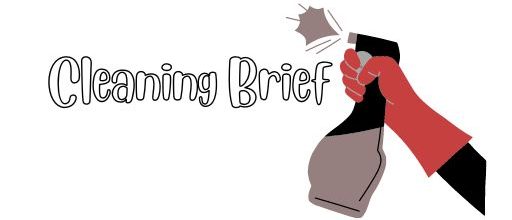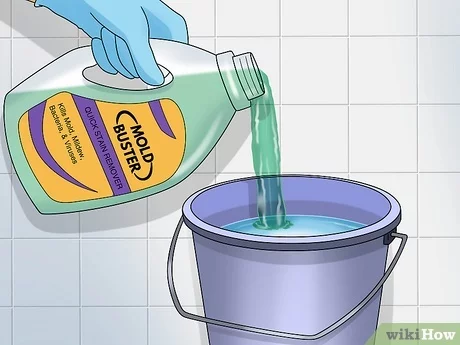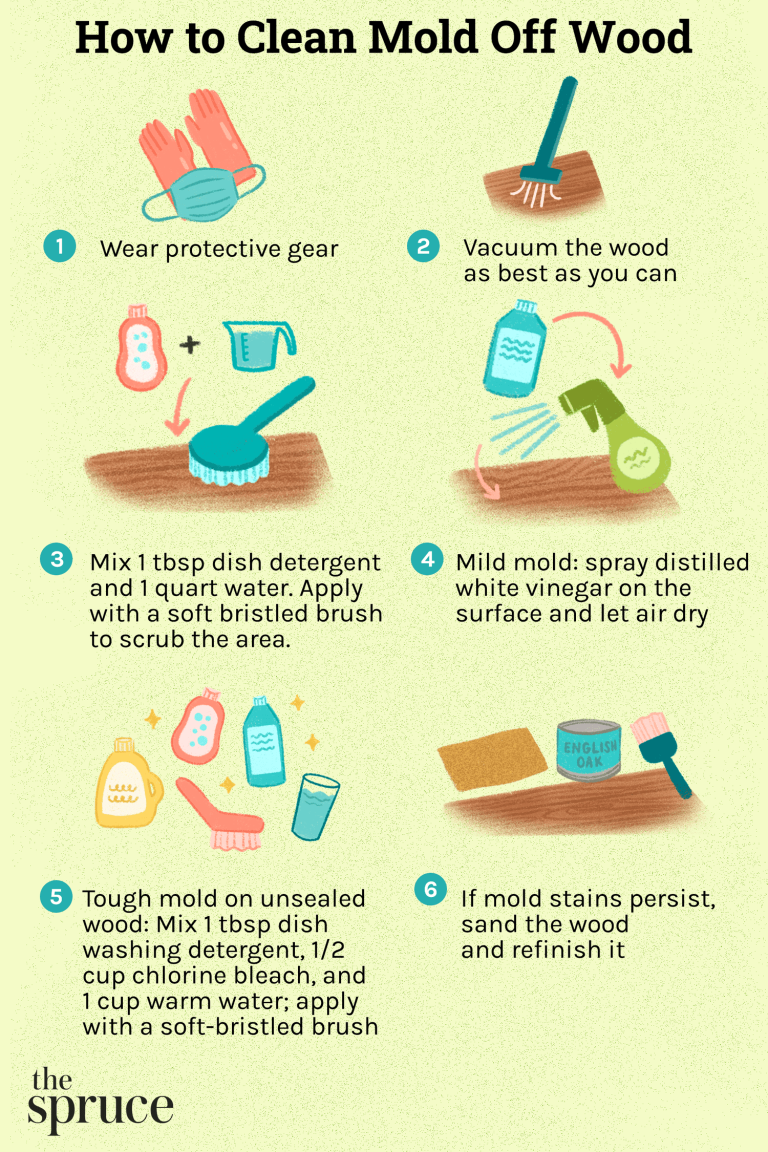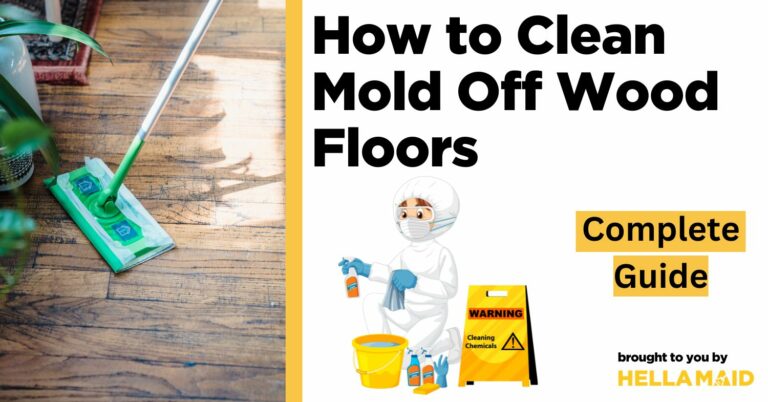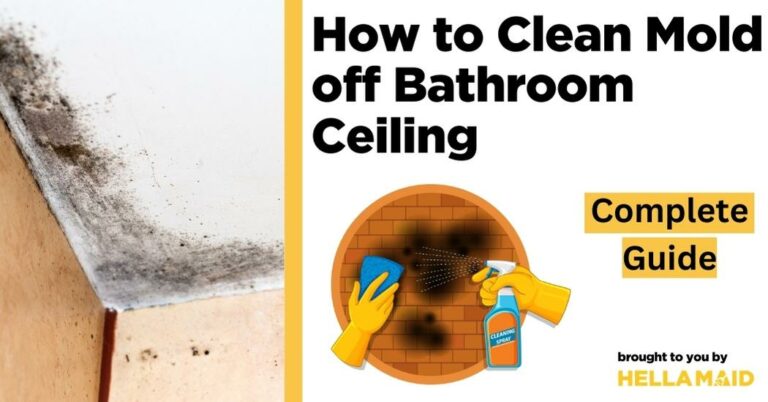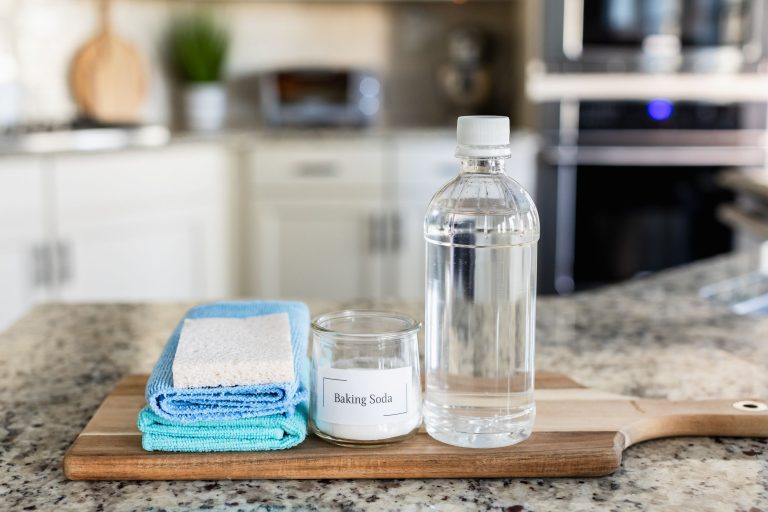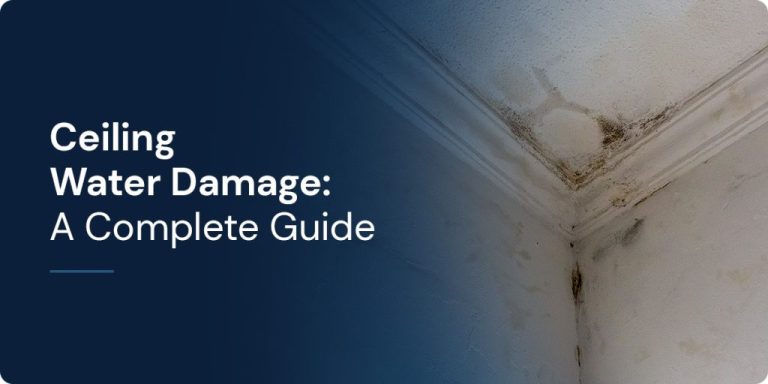How to Safely and Effectively Clean Mold off Concrete: Expert Tips
To clean mold off concrete, use a mixture of bleach and water. Mold can be a common problem on concrete surfaces, particularly in damp and humid areas.
If left untreated, it can cause damage to the concrete and even pose a health risk. Fortunately, there is an effective way to clean mold off concrete. By using a mixture of bleach and water, you can easily remove mold and prevent it from returning.
We will provide a step-by-step guide on how to clean mold off concrete, including the necessary supplies and safety precautions. With these simple but effective methods, you can restore the cleanliness and appearance of your concrete surfaces. So, let’s get started and say goodbye to mold!
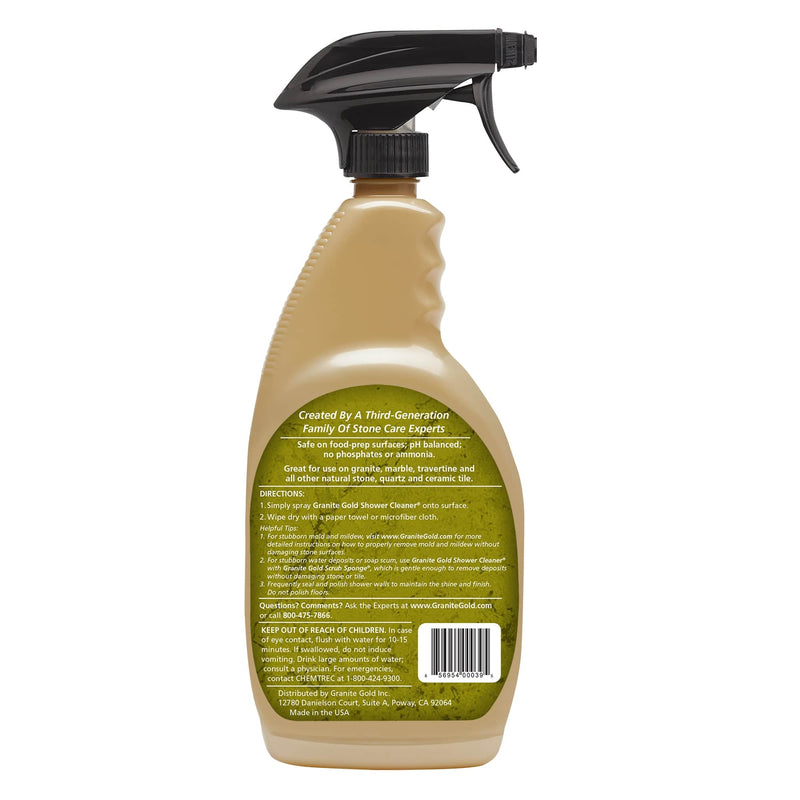
Credit: granitegold.com
Identifying Mold On Concrete
To identify mold on concrete, look for black, green, or white spots. To clean mold off concrete, use a mixture of water and detergent, or a commercial mold remover. Scrub the affected area thoroughly and rinse with clean water. Repeat if necessary to ensure thorough removal.
Regularly inspect and clean concrete surfaces to prevent mold growth.
Recognizing Mold Signs
Identifying mold on concrete is crucial to prevent further damage and maintain a clean environment. Mold can thrive in damp areas and cause health issues if left untreated. Recognizing the signs of mold growth on concrete can help you take prompt action.
Here are some signs that indicate the presence of mold:
- Visible black or greenish spots on the concrete surface
- An unpleasant musty odor
- A fuzzy or powdery texture on the concrete
If you spot any of these signs, it’s important to address the mold problem as soon as possible to prevent it from spreading and causing further damage.
Common Areas For Mold Growth
Mold growth on concrete is common in areas where moisture accumulates. Understanding the common areas where mold tends to grow can help you be proactive in preventing its occurrence.
Here are some common areas on concrete where mold can thrive:
- Basements and crawl spaces
- Bathrooms and showers
- Garages and storage areas
- Exterior walls and foundations
- Concrete patios and walkways
Mold can easily develop in these areas due to high humidity, water leaks, or lack of proper ventilation. Regular inspection and maintenance are essential to keeping mold growth at bay.
By promptly identifying mold signs and understanding the common areas for mold growth on concrete, you can take effective measures to clean and prevent mold infestation, ensuring a safe and healthy environment.
Safety Precautions
Before you begin the task of cleaning mold off concrete, it is essential to prioritize your safety. Mold can pose health risks, so taking necessary precautions is crucial. In this section, we will discuss the protective gear you should wear and the importance of ventilation and containment to minimize exposure.
Protective Gear
When dealing with mold, wearing the right protective gear safeguards your health. Here are some essential items to consider:
- Respiratory Mask: Choose a mask specifically designed for mold spore filtration to prevent inhalation.
- Gloves: Opt for heavy-duty gloves made from materials like nitrile or rubber to protect your hands from direct contact.
- Eye Protection: Wear safety goggles or glasses to shield your eyes from mold spores or cleaning agents.
- Disposable Coveralls: These full-body suits will help prevent mold spores from clinging to your clothing or skin.
- Boots or Shoe Covers: Use waterproof boots or shoe covers to avoid tracking mold spores into other areas of your home.
Ventilation And Containment
Adequate ventilation and containment are fundamental in limiting mold exposure during the cleaning process. These measures help protect you and prevent the spread of mold spores to other areas of your home. Consider the following recommendations:
- Open Windows and Doors: Increase air circulation in the area by opening windows and doors.
- Use Fans: Position fans to direct air outside, aiding in the removal of mold spores.
- Create a Containment Area: Seal off the affected area with plastic sheeting to prevent mold spores from spreading to other parts of your home.
- Negative Air Pressure: Set up a high-efficiency particulate air (HEPA) filter near the containment area to capture airborne mold spores.
- Seal HVAC Vents: Use plastic sheeting or tape to cover HVAC vents in the vicinity of the cleaning area.
By following the safety precautions outlined above, you can ensure your well-being while effectively tackling mold on concrete surfaces. Remember, safeguarding your health is paramount throughout the cleaning process.
Cleaning Supplies And Tools
Want to know how to clean mold off concrete? Discover the best cleaning supplies and tools to effectively tackle mold and keep your concrete surfaces looking pristine.
Cleaning Supplies and Tools When it comes to cleaning mold off concrete, having the right supplies and tools is essential for effectively tackling the task. Here’s a breakdown of the essential items you’ll need to ensure successful mold removal. “`htmlEffective Cleaning Agents
“` When dealing with mold on concrete, using the right cleaning agents is crucial for achieving optimal results. Here are some effective cleaning agents: – Bleach: Known for its powerful mold-killing properties, bleach is a highly effective option for removing mold from concrete surfaces. – Vinegar: A natural and eco-friendly alternative, vinegar can also be used to combat mold on concrete. Its acidic nature helps in loosening and killing the mold. – Commercial Mold Cleaners: There are various commercial mold cleaners available in the market formulated specifically for mold removal on concrete. These products often contain ingredients designed to penetrate and eliminate mold effectively. “`htmlEssential Equipment
“` In addition to using the right cleaning agents, having the essential equipment is equally important. Here’s the equipment you will need: – Protective Gear: Prioritize safety by wearing protective gear, including gloves, a mask, and goggles, to shield yourself from mold spores and cleaning agents. – Scrubbing Brush or Broom: A stiff-bristled brush or broom is necessary for physically removing the mold from the concrete surface. – High-Pressure Washer: For larger outdoor concrete areas, a high-pressure washer can be a valuable tool to effectively blast away mold and grime. – Spray Bottle: When using homemade or diluted cleaning solutions, a spray bottle is useful for applying the solution evenly across the affected area. – Bucket: Having a bucket on hand to mix cleaning solutions or carry tools can make the cleaning process more efficient. By ensuring that you have the right cleaning agents and essential equipment, you can effectively eliminate mold from concrete surfaces and restore their cleanliness and appearance.:max_bytes(150000):strip_icc()/clean-mold-off-wood-4767277-Vertical-FINAL-50d54949a7af4fc6a81c5ab2071249c4.png)
Credit: www.thespruce.com
Step-by-step Cleaning Process
Cleaning mold off concrete is essential to maintain a healthy and clean environment. Whether it’s the walls of your basement, outdoor patio, or garage floor, mold growth can occur due to moisture accumulation. To tackle this issue effectively, follow these simple steps:
Preparation
To start the cleaning process, make sure you gather the necessary materials:
- A protective mask and gloves
- A scrub brush with stiff bristles
- A bucket
- A cleaning solution (choose one suitable for removing mold from concrete)
- A hose or pressure washer
Once you have all the materials ready, it’s time to move on to the actual cleaning.
Application Of Cleaning Solution
Before applying the cleaning solution, it’s important to wet down the affected area with clean water. This helps to prevent the mold spores from spreading into the air. After wetting the area, follow these steps:
- Dilute the cleaning solution according to the manufacturer’s instructions.
- Pour the solution into the bucket.
- Using the scrub brush, apply the cleaning solution to the moldy concrete surface.
- Let the solution sit for about 10-15 minutes to allow it to penetrate the mold.
Scrubbing And Rinsing
Now it’s time to scrub away the mold and rinse off the cleaning solution:
- Take the scrub brush and vigorously scrub the moldy areas, ensuring you get into all the cracks and crevices.
- After scrubbing, rinse the area with clean water. A hose or pressure washer can be used for this step.
- Make sure to rinse thoroughly to remove any leftover traces of mold and cleaning solution.
- Repeat the scrubbing and rinsing process if necessary, until all visible mold is gone.
Remember, it’s important to be thorough while scrubbing and rinsing to completely remove the mold and prevent regrowth.
By following these step-by-step instructions, you can effectively clean mold off concrete surfaces. Regular maintenance and keeping the area dry will help prevent future mold growth. Remember to wear protective gear and work in a well-ventilated area while cleaning. Now, you can enjoy a clean and mold-free environment once again!
Preventative Measures
Preventative measures are essential in knowing how to effectively clean mold off concrete surfaces. By implementing regular cleaning routines, using appropriate cleaning agents, and ensuring proper ventilation, you can proactively prevent mold growth and maintain a clean and healthy environment.
Moisture Control
Moisture is one of the main factors that contribute to the growth of mold on concrete surfaces. By controlling moisture, you can significantly reduce the chances of mold appearing in the first place. Here are some effective moisture control methods:
- Fix leaks immediately.
- Ensure proper drainage around the concrete area.
- Redirect water away from the foundation.
- Use dehumidifiers in damp areas.
- Insulate cold surfaces like pipes to prevent condensation.
Regular Maintenance
Regular maintenance is key to preventing the growth of mold on concrete surfaces. By taking proactive measures, you can keep your concrete clean and free from mold. Follow these maintenance tips:
- Clean your concrete regularly using a mild detergent and water.
- Remove any debris or dirt that may trap moisture.
- Inspect your concrete regularly for any signs of mold growth.
- Seal your concrete to provide an additional barrier against mold.

Credit: granitegold.com
Frequently Asked Questions For How To Clean Mold Off Concrete
Can You Clean Mold Off Concrete Surfaces?
Yes, you can clean mold off concrete surfaces. Mold can thrive in damp areas, but regular cleaning with a mold and mildew remover can effectively remove it. Scrub the affected area with a brush or sponge, rinse thoroughly, and ensure the surface is completely dry to prevent the growth of mold in the future.
What Causes Mold To Grow On Concrete?
Mold grows on concrete surfaces due to the presence of moisture and organic material. High humidity, water leaks, or poor ventilation can contribute to mold growth. Concrete itself is not a food source for mold, but dust, dirt, or other organic materials on the surface can provide nutrients for mold spores to thrive.
Is It Safe To Clean Mold Yourself?
Yes, it is generally safe to clean mold yourself as long as you take the necessary precautions. Wear protective gloves, goggles, and a mask to avoid direct contact with mold spores. Use a mold and mildew remover specifically designed for the surface you are cleaning.
If the mold infestation is extensive or poses health risks, it may be best to hire a professional mold remediation service.
Conclusion
In the end, removing mold from concrete is a manageable task with the right approach. By using natural solutions such as vinegar or hydrogen peroxide, you can effectively eliminate mold while being mindful of the environment. Regular maintenance and addressing moisture issues are crucial in preventing future mold growth.
With these tips, you can keep your concrete surfaces clean and mold-free for the long term.
